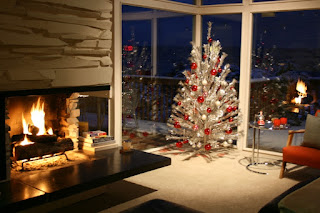Number one on your Christmas wish
list to Santa last year was a brand new conservatory – you must have been on
the ‘nice’ list in 2014 because as Christmas approaches once more, you are
sitting in the comfort and new space that your Christmas gift conservatory has
provided! This year, however, will be the first year you can actually decorate
and dress it for the holiday season and there are so many good ideas and
exciting things you can do with this extra room.
First things first, will the
conservatory be the focal point of Christmas in your home or just a room to
spill over into when all the other rooms get a bit cramped? For the purposes of
this article, we will assume it’s intended to be somewhat of a main attraction.
 |
| Christmas tree |
Christmas chair
conundrum
Making room for Christmas
decorations can be tricky, especially when it comes to finding somewhere to put
the tree. Usually a chair has to be sacrificed and put away (perhaps in the
loft or garage) for a few weeks, so that the tree can take centre stage.
However, losing a chair at Christmas time is far from ideal, especially if
you’re expecting lots of friends and family to visit.
Fortunately, this year, the new
conservatory can come to the rescue and not only ensure there is enough space
for Christmas decorations and other bits and bobs but you can also keep that
chair handy, so that everyone has a place to sit!
It’s all about the Christmas
tree!
If your conservatory is large
enough – this can be the main feature of the room. Do you prefer a real tree to
enjoy that lovely fresh, leafy, woody scent or is it worth investing in one of
the many classy artificial trees that are now available, that you can bring out
every year with the minimum of fuss?
Whatever you decide, the ideal
place for the tree, especially if your conservatory has a bay window, is in
that recess. (Unless the doors are used frequently in winter, in which case you
may need a plan B). In that recess, however, the tree will mostly be out of the
way, but still central and visible in all its splendour from the outside. If
you opt for a real tree, another bonus for having it by the doors is when the
needles start to drop, they won’t be traipsed around the house quite so much.
Decorating the tree will very
much depend on the theme you have chosen. If the room is to be used as the
dining area on Christmas day then careful attention needs to be paid to the
decorations both on the tree and the table to ensure they coordinate. For example, if you have decided on a modern
theme using glass baubles (perhaps in shades of light blue) it’s a good idea to
also use the same style baubles you used on the tree to fill a couple of
decorative vases and place them at both ends of the table. Another option could
involve scattering a few of the baubles in random clusters across the table.
Dressing the rest of
the festive conservatory room
There are quick and easy ways to create
that magic, festive feel in addition to the tree and table dressings. The use
of fairy lights and candles can create a soft and sparkly feel to the room,
with light and shadow flickering as the baubles gently sway in the warmth of
the room.
Hanging decorations made from
frosted glass at the windows can also soften the expanse of glazing while adding
to the festive ambience. Contemporary, seasonal wreaths can be hung on doors,
walls and even used as a centre piece on the table, with a display of candles
in the middle.
A Christmas
conservatory centre piece
We have already mentioned the
dining table and if you do intend to eat here at Christmas, then it really will
be the centre piece of the room, so why not be really flamboyant? Re-cover your
existing chairs, buy a new tablecloth, treat yourself to a fabulous new dinner
set and remember to tie in those all-important decorations as you go along.
Making individual place names is a lovely touch – you can even personalise
Christmas crackers, with each one containing a specifically bought little gift
for each person dining with you.
Don’t forget the New
Year’s party!
While you have the room looking
its finest, you might as well enjoy it over the New Year period too. Everybody
brings in the New Year in their own way but
whether you are going for a full on party with dancing or a formal meal you
only need to tweak a few things here and there to let people know that this is
New Year and not Christmas.
Don’t take the Christmas tree
down or the bulk of the decorations, many will work just as well at this time
of year. Simply change some of the Christmas themed candles to white or silver,
take the glass ornaments hanging at the windows down and perhaps replace them
with a New Year banner and some balloons and get ready for the countdown!
If the style of your celebrations
are to be more party like, then moving the table from the centre of the room
will provide a little space for those midnight dances. You can move it to the
side and use it as your food and drinks buffet table.
If you are having a more
civilised dinner party then nothing much needs to change as far as the layout
of the room is concerned - just a quick revamp of the table decorations, table
cloth and napkins etc.
So, last Christmas you received
your most wanted gift – this year you can fully unwrap it and show it off! For
more information about the kind of conservatory designs
available, please visit our main website at www.foxfurd.com



















